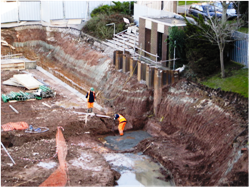
FIRST RESPONSE
During development of a ‘beta’ test site we received an email from Andrew Hunn, an archaeologist, who was logging a pipeline trench near Tirley, Gloucetershire. Andrew’s images and site description became the first external GeoExposures record (Figure 2, above left). Coincidentally, the faulted Mercia Mudstone (Upper Triassic) exposure is the same age and formation as our example site based on exposures of the foundations of the William Smith Building at BGS Keyworth. We hope ‘the father of English geology’ would approve of the latest format for recording geological information. (Meanwhile, Andrew Hunn reports that he has 14 years of pipeline records that may be of interest…!)
Image: Figure 3. GeoExposures website example showing the Upper Triassic Branscombe Mudstone Formation exposed in the excavations for the William Smith Building, BGS, Nottingham in 2008.
We are keen to see this website as a geoscience community site, rather than an ‘official’ BGS site. Our vision is to deploy the software in a usable format for common access and as such, Geoexposures is made available under a Creative Commons licence. We hope that professionals in the civil engineering and quarrying industries will also be keen to submit records of short-lived exposures at their sites. BGS will monitor submissions for improbable records (dinosaur tracks in Cambrian mudrocks… graptolites in Carboniferous shales, etc.), but we do not intend to rigorously verify the records. Comments and suggestions can be sent in, and indeed we hope that GeoExposures will generate vibrant discussions. We envisage that any scientific publications arising from GeoExposures records will duly acknowledge the source material.
Finally – we would stress that permission to enter onto sites (actual, as well as virtual) remains entirely the responsibility of the individual, as is health and safety. So, please give it a go - and get logging!